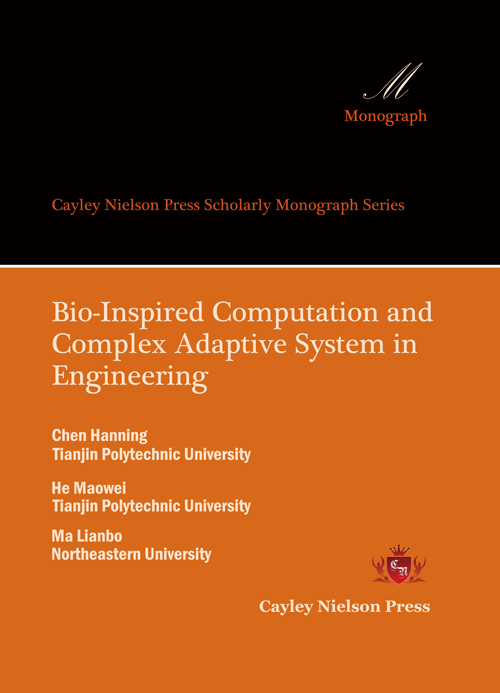
BIO-INSPIRED COMPUTATION AND COMPLEX ADAPTIVE SYSTEM IN ENGINEERING

Chen Hanning
Tianjin Polytechnic University
He Maowei
Tianjin Polytechnic University
Ma Lianbo
Northeastern University
Copyright © 2017 by Cayley Nielson Press, Inc.
ISBN: 978-0-692-85809-7
Cayley Nielson Press Scholarly Monograph Series Book Code No.: 129-6-5
US$105.00
Preface
...........
Contents
1 Introduction......................................................................................... 1
1.1 From Bionics To Bio-Inspired Computing..................................................... 1
1.2 Bio-Inspired Computing And Complex Adaptive Systems.................. 8
1.3 The Main Branch Of Bio-Inspired Computing............................................. 9
1.4 Contents Of This Monograph.............................................................................. 11
2 Population Information Communication Model....................... 13
2.1 The Internal Information Exchange And Cooperation Mode........ 13
2.1.1 Biological Population........................................................................................... 13
2.1.2 Information Exchange......................................................................................... 14
2.1.2.1 Types Of Information Transmission...................................................... 14
2.1.2.2 Information Communication....................................................................... 17
2.1.3 Cooperation And Distributed Control....................................................... 20
2.1.3.1 Cooperation And Division Of Labor In Ant Colony...................... 21
2.1.3.2 Cooperation And Division Of Labors In Bee Colony................... 22
2.1.3.3 Cooperation And Division Of Labors In Bird Colony.................. 23
2.2 The Design Of Computing Mode Based On The Behavior Of Biological Group Behavior 24
2.2.1 The Unified Optimization Framework Based On The Group Behavior 24
2.2.2 Basic Operations Based On The Group Behaviors........................... 26
2.2.2.1 Reproduction........................................................................................................ 26
2.2.2.2 Migration.................................................................................................................. 27
2.2.2.3 Division Of Labor................................................................................................ 27
2.2.2.4 Communication.................................................................................................... 28
2.3 Population Modeling And Simulation Analysis........................................ 31
2.3.1 The Formalization Definition For Biological System Population 31
2.3.2 The Individual Communication Model In The Population........... 39
2.3.2.1 Formal Description Of Topological Structure.................................. 40
2.3.2.2 Static Topological Structure......................................................................... 42
2.3.2.3 Dynamic Topological Structure................................................................. 45
2.4 Conclusions.................................................................................................................... 47
3 A Multi-Swarm Optimizer For Rfid Network Planning............ 48
3.1 Introduction................................................................................................................... 49
3.2 Rfid Network Planning Problem Formulation......................................... 52
3.2.1 Optimal Tag Coverage.......................................................................................... 53
3.2.2 Reader Collision Avoidance............................................................................. 54
3.2.3 Economic Efficiency.............................................................................................. 54
3.2.4 Load Balance............................................................................................................. 55
3.2.5 Combined Measure............................................................................................... 55
3.3 Ps2o Algorithm............................................................................................................. 56
3.3.1 Canonical Particle Swarm Optimization................................................... 56
3.3.2 The Proposed Multi-Swarm Optimizer..................................................... 57
3.4. Benchmark Test.......................................................................................................... 63
3.4.1 The Benchmark Function.................................................................................. 63
3.4.2 Settings For The Algorithms............................................................................ 65
3.4.3 Simulation Results.................................................................................................. 70
3.5 Rfid Network Planning Based On Ps2o......................................................... 71
3.5.1 Rfid Network Planning Procedure.............................................................. 71
3.5.2 Illustrative Example.............................................................................................. 74
3.6 Conclusions.................................................................................................................... 81
4 Bacterial Colony Foraging Algorithm: Combining Chemotaxis, Cell-To-Cell Communication, And Self-Adaptive Strategy............... 83
4.1 Introduction................................................................................................................... 83
4.2 Classical Bacterial Foraging Optimization................................................... 88
4.2.1 Bfo Model.................................................................................................................... 89
4.2.2 Step-By-Step Algorithm...................................................................................... 92
4.2.3 Bacterial Behaviors In Bfo................................................................................ 96
4.3 The Bacterial Colony Foraging Optimization............................................ 97
4.3.1 Cooperative Foraging In Bacteria Life-Cycle........................................ 98
4.3.2 Area Concentrated Search............................................................................. 100
4.3.3 Bacterial Cooperation By Cell-To-Cell Communication............... 101
4.3.4 The Proposed Algorithm................................................................................ 102
4.4 Benchmark Function Test.................................................................................. 110
4.4.1 Static Test Functions.......................................................................................... 110
4.4.2 Dynamic Test Functions.................................................................................. 112
4.4.2.1 Moving Peaks Benchmarks....................................................................... 112
4.4.2.2. Performance Evaluation Criteria.......................................................... 116
4.4.3 Settings....................................................................................................................... 117
4.4.4 Experiment 1: Numerical Results And Comparison...................... 118
4.4.4.1 Results For The Classical Test Functions......................................... 118
4.4.4.2 Results For The Cec05 Test Functions.............................................. 122
4.4.4.3 Results For The Dynamic Test Functions........................................ 124
4.4.5 Experiment 2: Bacterial Behavior Simulation In Bcfo Model.. 129
4.4.5.1 Self-Adaptation Of A Single Bacterium............................................... 129
4.4.5.2 Cooperation Between Two Communicating Bacteria.............. 133
4.4.5.3 Population Dynamic Of The Bacterial Colony............................... 134
4.5 Real-World Application........................................................................................ 136
4.5.1 Dynamic Optimization For Rfid Network............................................. 136
4.5.2 Optimization Schemes Based On Bcfo.................................................... 141
4.5.3 Simulation Results............................................................................................... 143
4.6 Conclusion.................................................................................................................... 145
5 Multi-Hive Bee Foraging Algorithm For Multi-Objective Optimal Power Flow Considering The Cost, Loss, And Emission............ 146
5.1 Introduction................................................................................................................ 147
5.2 Principle Of Multi-Objective Optimization................................................ 150
5.3 Optimal Power Flow Problem Formulation............................................ 151
5.3.1 Objective Functions............................................................................................ 153
5.3.2 Constraints............................................................................................................... 154
5.4 Multi-Hive Multi-Objective Bee Algorithm............................................... 156
5.4.1 The Motivation...................................................................................................... 156
5.4.2 The Single Hive Algorithm............................................................................. 159
5.4.2.1 External Archive............................................................................................... 159
5.4.2.2 Comprehensive Learning Strategy....................................................... 160
5.4.2.3 Greedy Selection Mechanism................................................................... 162
5.4.2.4 Crowding Distance.......................................................................................... 162
5.4.3 Multiple Hive Cooperative Mechanism.................................................. 164
5.4.3.1 Interaction Topology..................................................................................... 165
5.4.3.2 Information Transfer Strategy................................................................ 166
5.5 Benchmark Test........................................................................................................ 168
5.5.1 Test Function.......................................................................................................... 168
5.5.2 Performance Measures................................................................................... 171
5.5.3 Experimental Setting......................................................................................... 173
5.5.4 Two Objective Functions................................................................................ 175
5.5.5 Three Objective Functions............................................................................. 179
5.6 Multi-Objective Optimal Power Flow Based On M2oba................... 182
5.6.1 Implementation Of The M2oba Algorithm For The Opf Problem 183
5.6.2 Best Compromise Solution Based On Fuzzy Decision................. 187
5.7 Simulation Results................................................................................................... 190
5.7.1 Case I: Two-Objective Opf Optimization................................................ 191
5.7.2 Case Ii: Three-Objective Opf Optimization........................................... 196
5.7.3 Statistical Test........................................................................................................ 198
5.7.4 Computation Time Analysis.......................................................................... 200
5.8 Conclusions................................................................................................................. 201
6 Biomimicry Of Root System Growth For Global Optimization Models And Emergent Behaviors....................................... 203
6.1. Introduction............................................................................................................... 203
6.2 Root Foraging Behaviors.................................................................................... 206
6.2.1 Root Growth Responds To Nutrition Gradient In Soil................. 206
6.2.2 Root Memory And Communication......................................................... 207
6.2.3 Auxin-Regulated Root System Development..................................... 208
6.3 Root System Growth For Optimization (Rsgo)..................................... 210
6.3.1 Auxin Concentration.......................................................................................... 210
6.3.2 Root Branching..................................................................................................... 212
6.3.3 Tropisms................................................................................................................... 213
6.3.4 Random Walk Of Lateral Roots.................................................................. 215
6.3.5 Root Tip Death...................................................................................................... 217
6.3.6 Rsga Algorithm...................................................................................................... 217
6.4 Test And Simulaiton............................................................................................... 217
6.4.1 Test Functions....................................................................................................... 217
6.4.1.1 Test Benchmarks............................................................................................. 217
6.4.1.2 Traveling Salesman Problem (Tsp)...................................................... 218
6.4.2 Parameters Settings........................................................................................... 218
6.4.3 Experimental Results........................................................................................ 222
6.4.3.1 Computation Results On Benchmarks................................................ 222
6.4.3.2 Computation Results On Tsp.................................................................... 226
6.4.4 The Simulation Of Root Growth Behaviors........................................ 230
6.4.4.1 Root Tropic Growth: Tropism................................................................. 230
6.4.4.2 Auxin Controlled Population Dynamic.............................................. 236
6.4.4.3 Root System Structure Formulation.................................................... 237
6.5 Conclusions................................................................................................................. 238
7 Conclusions...................................................................................... 240
References.......................................................................................... 241
Readership
This book should be useful for students, scientists, engineers and professionals working in the areas of optoelectronic packaging, photonic devices, semiconductor technology, materials science, polymer science, electrical and electronics engineering. This book could be used for one semester course on adhesives for photonics packaging designed for both undergraduate and graduate engineering students.
